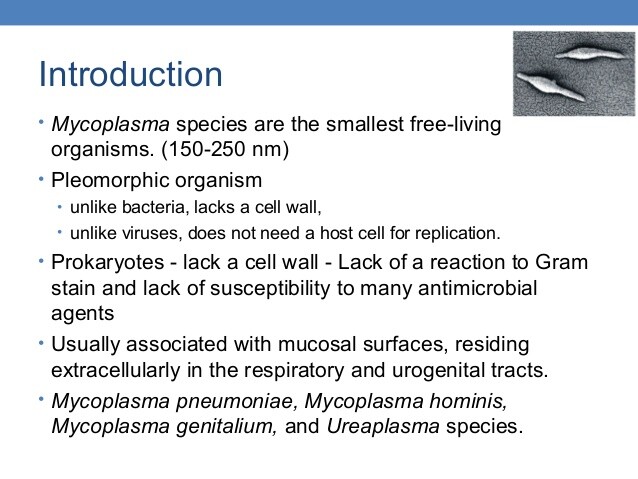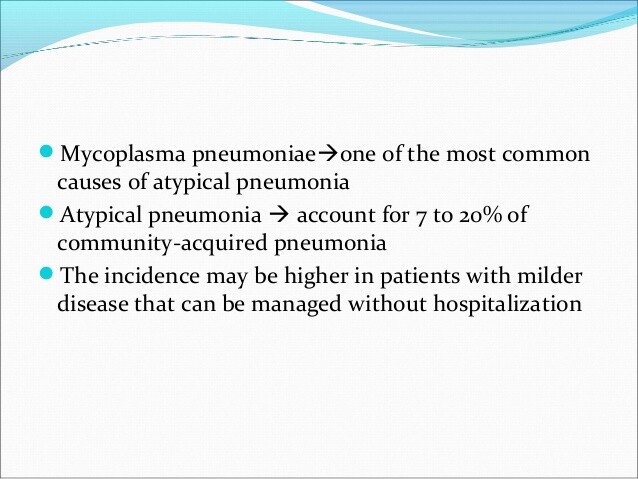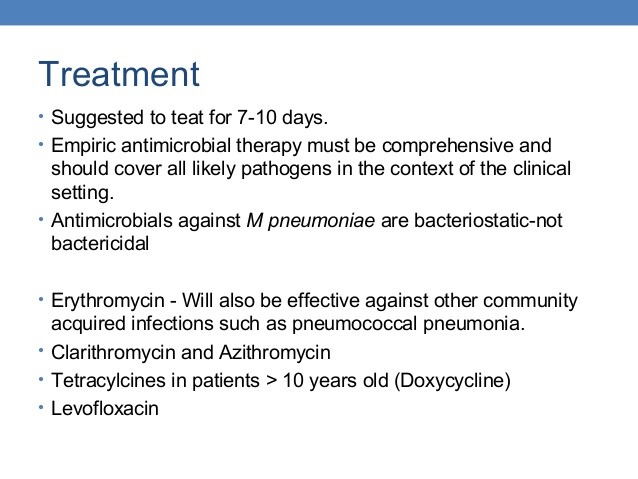Mycoplasma Pneumoniae is an important cause of upper and lower respiratory infections in both adults and children.
Extrapulmonary involvement, including dermatological, neurological, cardiac, musculoskeletal, and vasculitic involvement, has also been associated with M pneumoniae infection in humans.
Essentials of Diagnosis
- Community acquired pneumonia.
- Extrapulmonary involvement is not infrequent.
- Inflammatory cells on sputum Gram stain but no predominant bacterial type.
- Coombs-positive hemolytic anemia.
- Cold agglutinin titer of = 1:32.
- Fourfold change in specific immunoglobulin G (IgG) or IgM titers.
General Considerations
Epidemiology
Infected humans are the only source of M pneumoniae organisms for transmission to new susceptible hosts. M pneumoniae is spread from one individual to another by respiratory droplets produced by coughing. Individuals at any age can be infected and develop disease, but those between the ages of 5 and 20 years are most often affected. M pneumoniae is a leading cause of pneumonia in school-aged children and young adults — especially those in military and college populations. Infections occur throughout the world and without regard for time of year. Immunity after infection is not long lasting.
Microbiology
M pneumoniae cannot be visualized with any routine stain because of its small size and lack of cell wall. It is difficult to cultivate in the laboratory due to its fastidious growth requirements; however, it does grow slowly in enriched liquid culture media and on special mycoplasma agar, such as SP 4, under aerobic conditions. M pneumoniae may require = 21 days before growth can be easily detected in a culture; M hominis and U urealyticum require 2-5 days.
Pathogenesis
The initial step in disease causation by Mycoplasma spp. is attachment to the cilia and microvilli of epithelial cells lining the respiratory tract.
Respiratory epithelial cells express complex oligosaccharides containing sialic acid in their apical regions that bind a Mycoplasma surface protein known as P1, located on a polar attachment structure.
Mycoplasma attachment to these cells precipitates a cascade of events characterized by ciliostasis, desquamation of the involved cells, and an inflammatory reaction.
Mechanisms of cytotoxicity may include direct damage to respiratory epithelial cells by substances elaborated by mycoplasmas such as hydrogen peroxide and free-oxygen radicals or damage resulting from the host inflammatory response. The plasma membrane surfaces of Mycoplasma spp. are covered with variable lipoproteins that display antigenic and immunomodulatory properties.
Clinical Findings
Respiratory Involvement.
Signs and Symptoms
M pneumoniae is associated with pharyngitis, nonpurulent otitis media, tracheobronchitis, and community-acquired pneumonia in humans. The latter two syndromes are by far the most common among those caused by M pneumoniae.
Despite earlier descriptions of an association with bullous myringitis, this finding does not appear to be a common feature of M pneumoniae infection. The pneumonia is usually self-limited and does not require hospitalization. However, in patients with sickle cell disease and other hemoglobinopathies, respiratory involvement by M pneumoniae can be severe and life-threatening.
Patients develop respiratory symptoms 2-3 weeks after exposure to the respiratory secretions of another infected individual. M pneumoniae respiratory tract disease usually presents with gradual onset of fever, malaise, headache, and cough.
The cough is usually minimally productive or nonproductive and is “hacking” in most patients; it can become debilitating or incapacitating and may produce sternal discomfort. Most of these symptoms resolve spontaneously in the vast majority of patients. However, in a minority, these upper respiratory symptoms progress to tracheobronchitis or pneumonia.
On occasion, M pneumoniae pneumonia begins abruptly. Pleuritic chest pain is rare and must be distinguished from the chest soreness due to muscle strain in cases of severe cough. Body temperature usually fluctuates between 101 and 102 °F; however, occasional temperature spikes > 102 °F can be seen. On physical examination, most patients do not appear acutely ill. The pharynx may appear erythematous, but cervical lymphadenopathy is rare or absent. M pneumoniae is a rare cause of isolated pharyngitis in children and adults. Lung auscultation may be entirely normal or may disclose only a few crackles.
Laboratory findings
Examination of sputum with the Gram stain usually reveals inflammatory cells in the absence of large numbers of bacteria or a predominant type. The peripheral leukocyte count is either within normal range or moderately elevated.
Imaging
Chest radiographic abnormalities are usually out of proportion to the physical examination findings. M pneumoniae has a predilection for the lower lobes and usually causes patchy alveolar or reticular infiltrates; however, lobar infiltrates have been described. Pleural effusions, if present, are small. Unusual radiological findings described in association with M pneumoniae pneumonia include diffuse interstitial infiltrates, mediastinal mass, hilar adenopathy, and pneumatocoeles.
Dermatologic Involvement
M pneumoniae infection has been associated with erythema multiforme major, or the Stevens-Johnson syndrome. Erythema multiforme major is an acute and often recurrent inflammatory disease of skin and mucous membranes. Erythema multiforme has been reported in as many as 7% of patients with M pneumoniae pneumonia, but has been associated, albeit less often, with other infectious agents including herpes simplex virus. Skin lesions of erythema multiforme include urticarial papules, macules with a “target” appearance, vesicles, and bullae. They occur on the backs of hands, palms, soles, and extensor surfaces of limbs, and they may become generalized. Stevens-Johnson syndrome is a vesiculobullous disease of the skin, mouth, eyes, and genitals. Most bullae affect the trunk, mouth, and genitals. The conjunctiva are usually injected. Drugs such as phenytoin, phenobarbital, sulfonamides, and penicillins can also be implicated as causative agents of erythema multiforme and Stevens-Johnson syndrome.
Cardiac and Vascular Involvement
Raynaud’s phenomenon has been described particularly in women with M pneumoniae infections. It may be related to the development in these patients of cold-sensitive IgM antibodies directed against the I antigen on circulating erythrocytes (cold agglutinins). These autoantibodies are responsible for a subclinical hemolytic anemia in ~ 50% of patients and a clinically significant anemia in a smaller percentage of patients. Cardiac arrhythmias including conduction defects, hemopericardium, myopericarditis, and congestive heart failure have also been associated with M pneumoniae infection. Other reported vascular complications include internal carotid artery occlusion, cerebral infarction, and infection of aneurysms and vascular grafts.
Neurologic Involvement
A number of neurologic syndromes have been ascribed to M pneumoniae, although a causal relationship is not well established. These syndromes include aseptic meningitis, meningoencephalitis, transverse myelitis, brain stem dysfunction, Guillain-Barre syndrome, and peripheral neuropathy. Cerebrospinal fluid (CSF) examination usually reveals < 500 leukocytes/mm3, a slightly elevated protein concentration, and normal to slightly decreased glucose concentration. In most cases a microbiological diagnosis has been established by serology. M pneumoniae rarely has been cultivated from CSF and has never been cultivated from brain tissue. A case of fatal encephalitis has been described in which M pneumoniae DNA was detected in CSF by polymerase chain reaction. It is important to emphasize that efforts should be made to rule out other causes of CNS disease before M pneumoniae is established as the etiologic agent.
Other Clinical Manifestations
Polyarthralgia, arthritis, and immune complex-associated renal disease have been associated with M pneumoniae infection.
Diagnosis
Methods for diagnosing M pneumoniae infection include cultivation, antigen and nucleic acid detection, and serology. Cultivation of M pneumoniae from tracheal aspirates, nasopharyngeal swabbings, sputum, or any body fluid should be attempted if the methods are available but they have a low yield and are cumbersome to perform due to the complex growth requirements of the organism. Specimens for culture should be transported in special media.
Detection of M pneumoniae antigens directly in sputum specimens is feasible by using a direct fluorescent antibody method or antigen-capture enzyme immunoassay, but the role of these antigens in the diagnosis of M pneumoniae disease has not been well established. Methods for detecting M pneumoniae DNA are also commercially available for use with throat swabs but are not available in most laboratories.
Serological testing is the most widely available and widely used approach for diagnosing M pneumoniae infections. Serological tests are rarely helpful during the acute illness. Paired measurements are most helpful; a fourfold titer difference between the acute and the convalescent serum antibody titer is considered diagnostic. Single measurements are of value for epidemiological purposes. IgG- and IgM-specific antibodies can be detected with indirect immunofluorescent antibody or enzyme immunoassay methods. Because of ease of use and reliability, enzyme immunoassay has become the preferred method. A complement fixation assay is less sensitive and is reserved for epidemiological purposes.
Demonstration of cold agglutinins can help to support the diagnosis of M pneumoniae pneumonia, although the finding is nonspecific. Cold agglutinins have been observed in adenovirus infections, infectious mononucleosis, cytomegalovirus infection, lymphoma, and other diseases. Nonetheless, a titer of = 1:32 is highly suggestive of infection with M pneumoniae. Cold agglutinins can also be detected at the bedside by drawing 1 mL of the patient’s blood into a blue top tube (containing citrate as the anticoagulant) and cooling the tube at 4 °C for 3-4 min. The reversible appearance of macroagglutination indicates the presence of cold agglutinins at a titer of approximately = 1:64.
Differential Diagnosis
Legionella spp., Chlamydia pneumoniae, Chlamydia psittaci, Streptococcus pneumoniae, Haemophilus influenzae, and Moraxella catarrhalis can cause a pneumonia with clinical features that are indistinguishable from those associated with M pneumoniae.
Treatment
The efficacy of antimicrobial agents in patients with M pneumoniae pneumonia is difficult to evaluate because this is often a self-limited disease. Antibiotics most likely shorten the duration of symptoms and may have an important role when infected patients are immunocompromised or are severely affected by the disease.
The most effective antimicrobial agents are macrolides, fluoroquinolones, and tetracyclines (Box 2). Macrolides are the first-line agents for treatment of M pneumoniae-associated disease.
Azithromycin and clarithromycin are better tolerated and easier to administer than erythromycin, but are more expensive. Fluoroquinolones should not be used in patients younger than 18 years, and tetracyclines should not be used in children younger than 9. The newer fluoroquinolones (levofloxacin, moxifloxacin, and gatifloxacin) with enhanced activity against S pneumoniae have reliable activity in vitro against M pneumoniae.
Most patients with pneumonia do not require hospitalization and are treated on an empirical basis. The recommended duration of therapy is not clear. Clinical relapse occurs in ~ 10% of patients and may warrant a longer course of antibiotic therapy, eg, 3 weeks.
Radiological improvement may lag behind clinical improvement for weeks.
Prevention
There are currently no recommended specific control measures for M pneumoniae outbreaks in closed communities. However, some studies have suggested the usefulness of prophylactic antibiotics administered to close contacts of case patients.
One study demonstrated that the administration of azithromycin, 500 mg on day 1 and 250 mg on days 2-5, to individuals at risk was beneficial in reducing the disease attack rate during an institutional outbreak of M pneumoniae pneumonia. There is no available vaccine.





